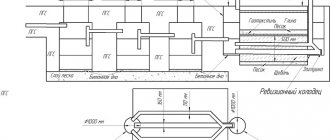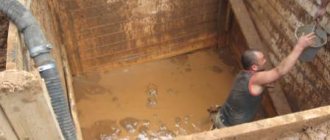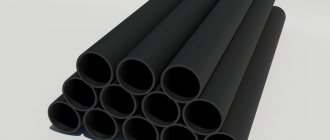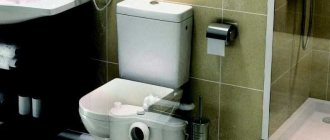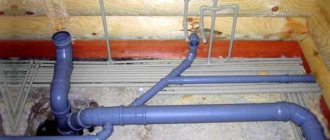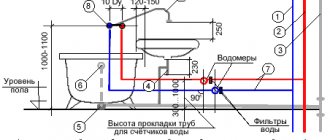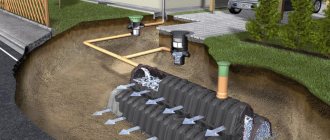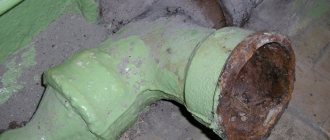If the slope of the sewer pipes does not meet the requirements of SNiP and the inlet of the riser is located at the level or above the drain from the sink, bathtub and toilet, the sewer system does not work correctly and blockages form in it.
From the article you will learn what the slope of sewer pipes should be, why sewerage does not work well with the wrong slope, and how to make the correct slope.
How does sewage work?
Water from toilets, sinks, bathtubs, washing machines, dishwashers and other appliances is drained into the drain. This water contains organic impurities ranging in size from hundredths of a millimeter to several centimeters. The composition and amount of impurities are different, so the sewer system is designed in such a way that waste and fecal water flows without delay.
The calculation method is described in SNiP 2.04.01-85. If we simplify the formulas, the correct slope depends on the flow rate of waste and fecal water and the diameter of the pipes. For thin pipes (40-50 mm) it corresponds to 2-3 cm per meter of length, for thick pipes (90-110 mm) 1-2 cm. If the slope is less, then large fragments of fecal and waste water get stuck in pipe joints, and small ones catch on unevenness and roughness of the pipe.
The low flow rate does not allow water to remove stuck or stuck fragments, resulting in a blockage. With an excessive slope, the speed of the water increases, so the fragments hit the uneven surfaces with greater force, so some of them stick to the pipes and form a blockage. Another unpleasant manifestation of excessive pipe slope is increased noise when draining water.
The slope is the difference in the heights of the water intake openings of the horizontal collector (lounger) and the intake opening of the vertical common house collector (riser). Therefore, the slope depends on the height of the hole in the riser, the level of the floor and the height of the receiving hole of the deck chair above the floor level.
Types of drain pipes for toilets
The phrase “faucet pipe” has a broad meaning; today we will look exclusively at the faucet pipe for the toilet. This is a continuation of the 110 mm sewer pipe with a cuff for connecting the toilet outlet. In fact, standard corrugation is one of the types of fan pipe.
There are many variations of fan pipes, but I would like to highlight the usual, straight one - in nine out of ten cases it is suitable for use. As a standard, the straight drain pipe has dimensions ∅110 mm × 250 mm (long) - it satisfies most toilet connection options. The pipe can be shortened to the desired length, the main thing is that it is inserted into the main sewer at least 50 mm.
When the height of the sewer outlet does not coincide with the height of the toilet outlet or for some reason does not fit with the oblique outlet, an eccentric-type drain pipe will come to the rescue. An eccentric allows you to connect a toilet when the axes of the sewer pipe and the outlet do not coincide. Similar situations arise when replacing a toilet with another model or thoughtlessly installing sewer pipes in a bathroom.
How to change the height of the intake hole in the riser
If you move the intake hole lower, keep in mind that the riser is a common house communication. If you do something wrong and deprive your upstairs neighbors of the opportunity to use the toilet normally, it will not turn out well for you.
If you cut a sewer into a riser lower than it is connected, consider the following. Without damaging the floor slab, the minimum height of the intake hole from the floor is 2.5 cm. To connect the sun lounger to the riser, you must use a clamp that blocks the drain hole by at least a quarter of the diameter in each direction.
The diameter of the lounger is 90-110 mm, therefore, to lower it lower than 2.5 cm, it is necessary to damage the floor slab.
The process of connecting to the riser is described in detail in the article Tapping into a sewer pipe - basic rules and points for tapping.
Unless you are a professional builder, do not damage the floor slab. This is life-threatening. According to Russian law, making changes to the design of a building without approval from the city department of architecture is illegal and is punishable by a large fine.
If the minimum distance from the floor to the riser inlet does not allow you to create the correct slope, raise the inlet of the sun lounger. To do this, raise the floor level or the installation level of plumbing fixtures.
Why did the toilet become lower after the toilet renovation?
Repairing a toilet has several successive stages, and maintaining the sequence is key in this matter. So:
- the toilet is dismantled;
- old facing material is dismantled;
- a new floor, walls, ceiling are being laid;
- The toilet is being installed.
For several reasons, this sequence is broken; the floor is dismantled and re-installed after the plumbing has been installed. The toilet sinks into the floor and becomes lower.
To avoid this, you must adhere to the rules for performing manipulations. But there are pitfalls here too. Let's look at several problematic situations in which the floor is laid after the toilet has been installed.
- Dismantling plumbing is not always possible without damaging consequences. If an old toilet is installed in an apartment using the installation methods used in Soviet times, then it is impossible to remove it without breaking: it is tightly “set” on the mortar, and the neck in the cast-iron sewer is also tightly sealed with mortar. Thus, it is assumed that old plumbing equipment will have to be disposed of. But it may happen that there is no money to buy a new one.
- The apartment where the toilet renovation is taking place is the only place of permanent residence. Since with the correct sequence of actions the repair will take 1-2 days, this option becomes unacceptable.
- There is no way to change the sewer pipes in the toilet, and the new toilet will not fit after laying the floor at the old height.
In these cases, laying the floor after installing the toilet is a forced, but still possible measure. This is where the problem of a “low” toilet arises.
Types of connections
If under no circumstances have you ever done such work with your own hands before, then you don’t understand exactly what is needed for this. When you come to the store, you must clearly know what you need, based on this, remember well everything you read below.
The main element is the connector, which provides a reliable joint. A lot will depend on his choice, so pay special attention to this aspect.
Today the following varieties are widely used:
- Corrugations (corrugated cuffs) . The most variable variety, since it allows you to create installation at any angle. It is usually used when the toilet is below the sewer level, but it is also suitable for more simple cases.
- Eccentric cuffs . Such products are not so universal, but at the same time they allow you to shift the placement of the toilet.
- PVC bends, pipes and adapters . This option is suitable if the toilet is located close to the riser. In addition, the price of such products is the lowest.
- Fan pipes are made mainly from porcelain. Installing such products is much more difficult than all previous ones. Based on this, if the choice falls on them, you need to invite an expert so as not to break expensive equipment.
When choosing a suitable product, consider the diameter of the sewer pipe for the toilet. It should be no larger than the hole on the sanitary product itself.
In addition, you will find the following tools useful:
- Sealant (it is better to use silicone).
- Special plumbing lubricant.
- O-rings made of rubber.
Connection
Now we will give a detailed answer to the question of how to connect a toilet to a sewer. As we have already said, the connecting elements are different, based on this, we will consider a couple of options for connecting the toilet to the sewer.
Ruffled cuff
Once again, we repeat that the use of devices contains the fewest pitfalls. If connecting a toilet to a sewer pipe is an unfamiliar procedure for you, then it is best to opt for it.
We will immediately see that when using an eccentric, the procedure will be completely the same.
So, the work is done in the following sequence:
- The outlet part of the cuff is inserted into a special hole in the sewer pipe.
Note! Choose the diameter carefully, and under such conditions you will only need to coat the joint with grease. Otherwise, you will have to try without jokes in order to prevent leaks.
- The toilet is placed in the intended installation location. If corrugation is used, then this can be done in virtually any place. But when using an eccentric, the toilet drain must be located at a small distance.
- Then we mark the places on the floor where the self-tapping screws (or bolts) will be screwed in to ensure reliable fixation.
- After this, the inside of the corrugation is lubricated with a sealing substance. With this end it is inserted into the corresponding hole in the outlet part of the toilet. After which it is securely fixed using self-tapping screws (bolts).
If you want to install it in a place that’s no joke, remote from the sewer pipe, in other words, a solution. Sewage pump for a toilet - this device allows you to install plumbing elements at any distance.
Adapter or fan pipe
We've dealt with the cuff, it's time to move on. Now our instructions will consider the connection procedure when using standard PVC elements. Let us remind you once again that this method is applicable only in conditions of ergonomic placement of the pipe.
In general, the technology is not sharply different from that presented above. But there are still differences.
Let's look at the highlights of this procedure:
- It is necessary to use special rubber seals (for both vertical and horizontal connections). They provide the tightest and most durable fit.
Tip: Buy a couple of spare seals. The fact is that in conditions of constant humidity they quickly begin to burst, so you must always have an additional element in stock in order to replace it in an emergency.
- Before installation, the entire inside of the pipe must be carefully coated with sealant. This will prevent leaks. In addition to this, it is also necessary to lubricate the toilet outlet pipe.
- PVC adapters do not bend, so the sanitary fixture must be installed strictly at a right angle. It is forbidden to allow distortion. Based on this, carefully prepare the installation site.
Now you understand how to connect a toilet to a sewer system. If you strictly follow all our instructions, you will definitely solve the task you have set for yourself.
